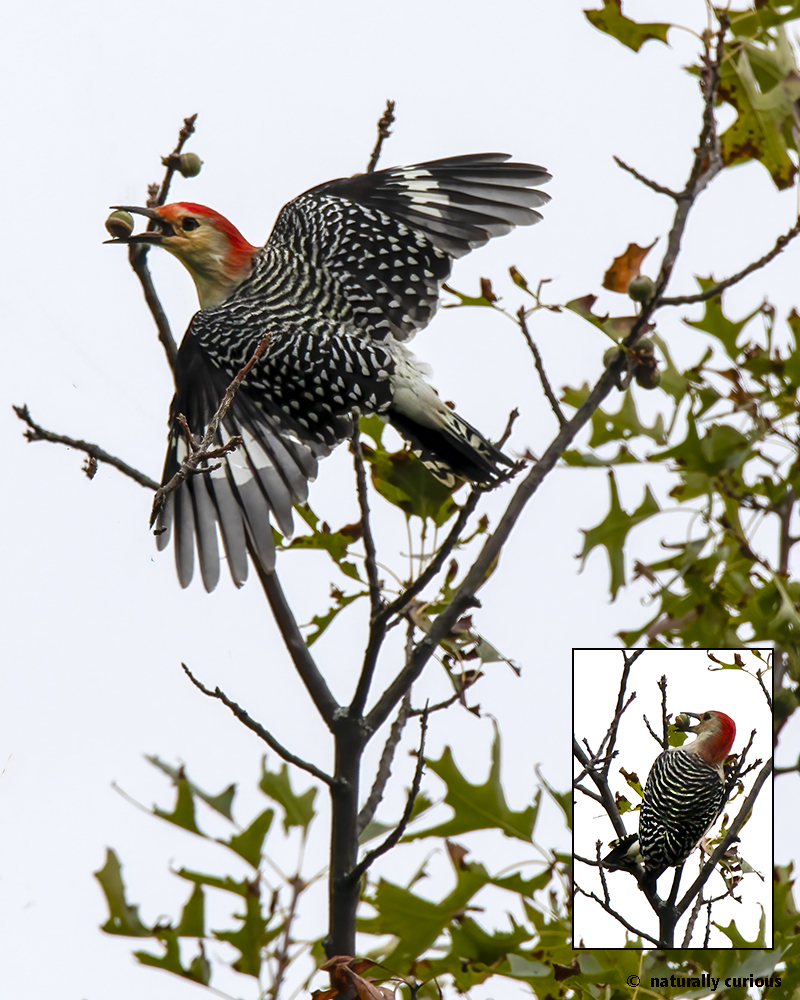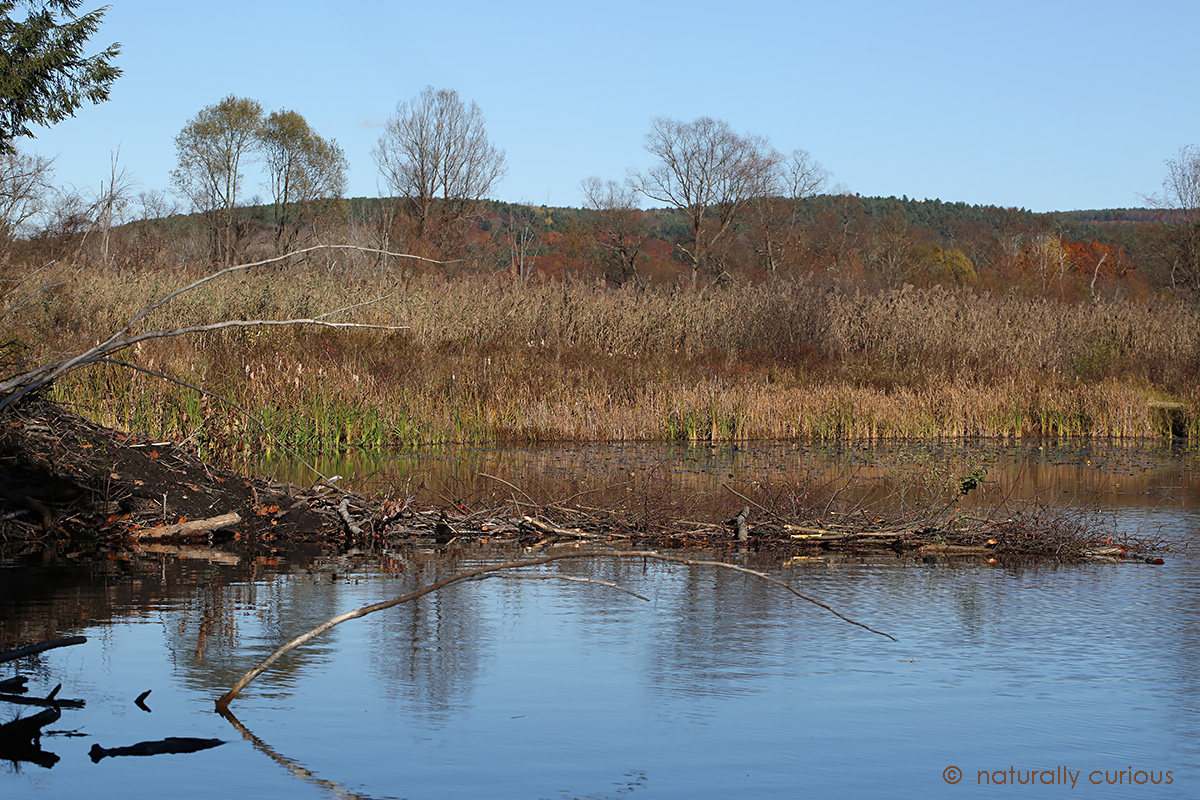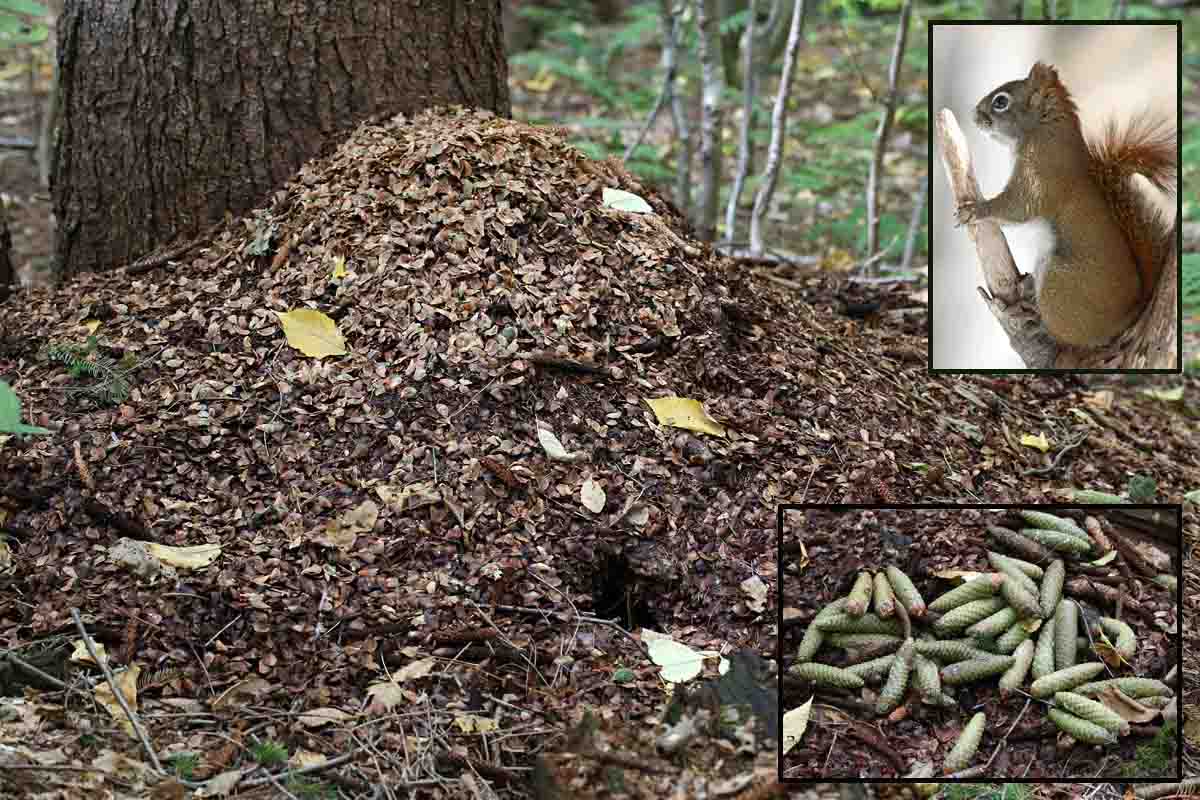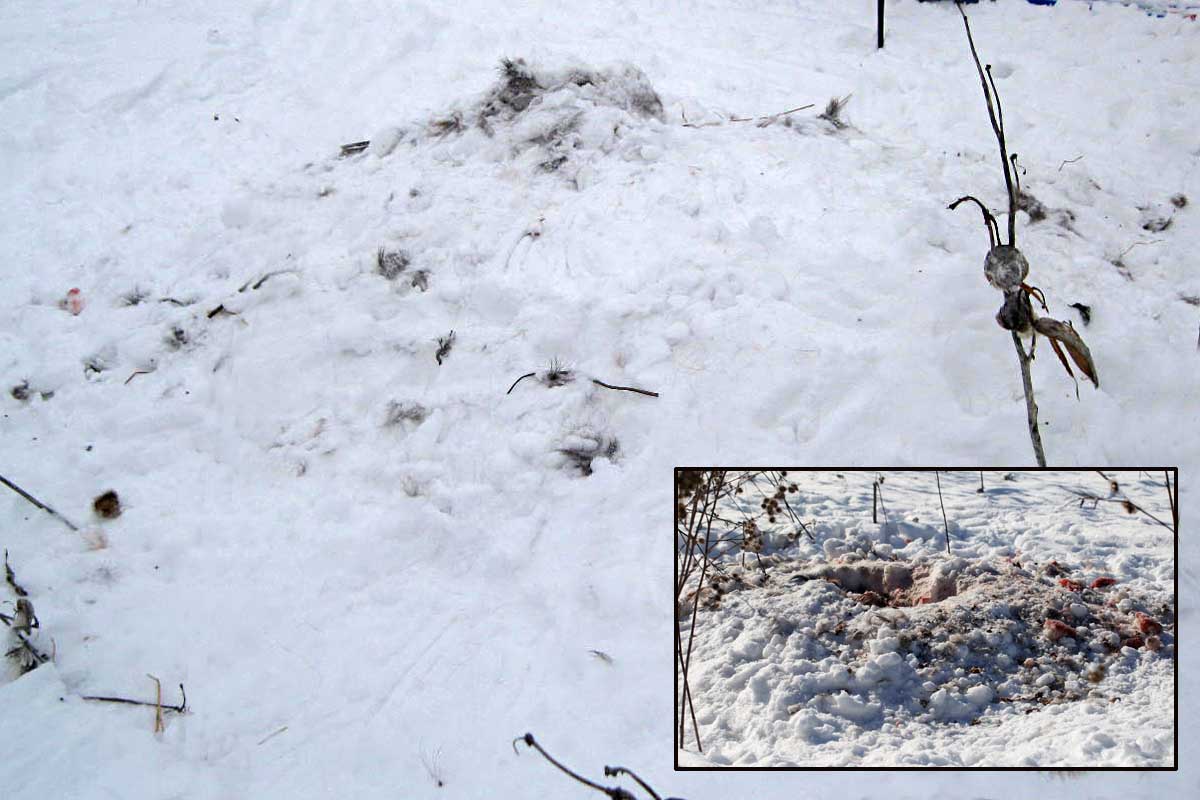Red-bellied Woodpeckers Eating & Caching Acorns

Red-bellied Woodpeckers have a wide-ranging diet consisting of nuts, fruits, frogs, minnows, nestling birds, songbird eggs, invertebrates, sap and nectar. At this time of year, acorns are a preferred food. While woodpeckers are well known for their ability to use their bills to drill into trees in order to extract insects, their use of their bills to extract the meat of nuts is less well-known. Often they will pluck an acorn off an oak and fly with it in their bill to a tree or post where they press it into a crevice. They then crack the shell of the acorn by hammering it with their bill, after which they extract the nutmeat.
Red-bellied Woodpeckers cache food throughout the entire year, but engage in this behavior more often during the fall. They return to their cached food throughout the winter. When you see a Red-bellied Woodpecker carrying something in its bill this time of year, follow its flight. If the bird happens to land, see if it tries to put the item in the crack of a tree or into a crevice. The list of items stored by this woodpecker includes acorns, nuts, seeds, fruits, fruit pulp, kernels of corn, suet, peanut butter, whole peanuts, and even insects. (Photo: male Red-bellied Woodpecker with Red Oak acorn)
Naturally Curious is supported by donations. If you choose to contribute, you may go to http://www.naturallycuriouswithmaryholland.wordpress.com and click on the yellow “donate” button.
Red Squirrels Caching Food For Winter

Both carnivores and herbivores cache, or store, food for later consumption. Black-capped Chickadees tuck seeds into bark crevices. Bobcats may cover their kills with leaves, grass, snow and even hair from their prey’s carcass. Grey Squirrels bury their nuts individually, while Red Squirrels often hide green cones in a pile of cone scales (middens) that accumulate at the site where the squirrels have previously eaten seeds, keeping the young cones moist so that they will retain the seeds within them.
Red Squirrels sometimes go one step further than most animals that cache food — they frequently preserve their food by drying it before storing it. You’ll recognize this when you see it – an apple or mushroom stuck in the crotch of two branches. Sometimes the dried food is collected and cached near their winter quarters, but often it remains lodged in tree branches until eaten. The pictured mushroom, which was hung out to dry, was reduced almost to mush by the torrential rains we’ve had lately. Eventually it will dry out and remain edible into the winter.
Naturally Curious is supported by donations. If you choose to contribute, you may go to https://naturallycuriouswithmaryholland.wordpress.com and click on the yellow “donate” button.
The Nuthatch Name

Have you ever thought about the derivation of the Red- and White-breasted Nuthatch’s common name? It comes from their habit of wedging a nut, acorn, etc. into a tree’s bark, and by repeatedly striking the nut, “hatching” or exposing the seed within it.
Many of these seeds are then stored in bark furrows for later consumption. In one study it was found that nuthatches spend more time caching husked than unhusked seeds (71% of sunflower seeds cached were husked). This inevitably would lower the expenditure of energy and time spent when consuming the cache later in the season. Hiding time, and time and distance flying from feeders to cache sites were longer when nuthatches hoarded husked than unhusked seeds, perhaps indicating their increased value to the birds. (photo: White-breasted Nuthatch with husked sunflower seed)
Naturally Curious is supported by donations. If you choose to contribute, you may go to http://www.naturallycuriouswithmaryholland.wordpress.com and click on the yellow “donate” button.
Beaver Winter Food Supply Cache

Once locked under the ice, beavers have only the food that they have had the foresight to store in their pond prior to it freezing to sustain themselves for the next four to five months. Sometime in September or October beavers start cutting down trees and limbing them. (The more northern the latitude, the earlier they begin this process.) Beavers have been found foraging over a third of a mile from their pond in the fall. At this time of year they tend to go further afield in order to find their preferred trees and shrubs – poplar, willow, alder and sugar maples. The branches are carried to the pond and hauled through the water to the lodge. When they approach the lodge the beavers dive down and push the butt end of the branches into the mud at the bottom of the pond and proceed to weave additional layers of branches into them.
Most caches are built as close to the entrance of the lodge as possible. A cache, or winter food supply pile, that feeds a colony of beavers consists of 1,500 to 2,500 pounds of edible bark, twigs and leaves. (On average, a beaver consumes 1 ½ pounds of food per day in the summer, and 2.2 pounds in the winter.) Because beavers don’t eat the wood, they must gather several tons of saplings and branches in order to have enough to survive.
If you look closely at yesterday’s close-up view of the food cache, you will see larger limbs on top of the pile. These larger logs are used to weight down the pile –they often consist of species that beavers aren’t particularly partial to, if they eat them at all. (Note proximity of food cache to the lodge, which is to the left in photo.)
Naturally Curious is supported by donations. If you choose to contribute, you may go to http://www.naturallycuriouswithmaryholland.wordpress.com and click on the yellow “donate” button.
Gray Squirrels Digging Up Cached Acorns
 If you have oak trees in the woods near you, chances are great that their acorns attracted wildlife this past fall, one of which was most likely a Gray Squirrel. Unlike Black Bears, Wild Turkeys and White-tailed Deer, which eat acorns immediately upon finding them, Gray Squirrels tend to cache acorns for winter consumption. They do so by burying them individually, often in fairly close proximity to where they find them. (Red Squirrels also cache food in the fall, but typically bury numerous seeds, mostly conifers and maples, in one spot.) When food becomes scarce, as it usually does this time of year, it is possible to find numerous holes dug in the snow, frequently with leaves and bits of acorn shells littering the snow around them. Tell-tale Gray Squirrel tracks leading to and from these holes identify the excavator.
If you have oak trees in the woods near you, chances are great that their acorns attracted wildlife this past fall, one of which was most likely a Gray Squirrel. Unlike Black Bears, Wild Turkeys and White-tailed Deer, which eat acorns immediately upon finding them, Gray Squirrels tend to cache acorns for winter consumption. They do so by burying them individually, often in fairly close proximity to where they find them. (Red Squirrels also cache food in the fall, but typically bury numerous seeds, mostly conifers and maples, in one spot.) When food becomes scarce, as it usually does this time of year, it is possible to find numerous holes dug in the snow, frequently with leaves and bits of acorn shells littering the snow around them. Tell-tale Gray Squirrel tracks leading to and from these holes identify the excavator.
Naturally Curious is supported by donations. If you choose to contribute, you may go to http://www.naturallycuriouswithmaryholland.wordpress.com and click on the yellow “donate” button.
Red Squirrels Making Middens
 Red squirrels bury food for winter consumption both individually as well as in caches or “middens.” These food supply piles may be in a hollow tree, in an underground den or in a hollow at the base of a tree. Middens consist of intact cones, cut when they are green with their seeds still enclosed, as well as debris (woody bracts, or scales, etc.) from the cones that accumulates from the squirrel’s eating the seeds. If a midden is located underneath a favorite feeding site, not only is the midden large (up to four feet tall), the moist, decomposing pile of scales provides an ideal place for stored cones to be kept fresh and viable, as the moisture keeps them from drying and opening. Other foods, including nuts, hawthorn and sumac fruit, are also stored in this way. (Note entrance hole at base of midden.)
Red squirrels bury food for winter consumption both individually as well as in caches or “middens.” These food supply piles may be in a hollow tree, in an underground den or in a hollow at the base of a tree. Middens consist of intact cones, cut when they are green with their seeds still enclosed, as well as debris (woody bracts, or scales, etc.) from the cones that accumulates from the squirrel’s eating the seeds. If a midden is located underneath a favorite feeding site, not only is the midden large (up to four feet tall), the moist, decomposing pile of scales provides an ideal place for stored cones to be kept fresh and viable, as the moisture keeps them from drying and opening. Other foods, including nuts, hawthorn and sumac fruit, are also stored in this way. (Note entrance hole at base of midden.)
Naturally Curious is supported by donations. If you choose to contribute, you may go to http://www.naturallycuriouswithmaryholland.wordpress.com and click on the yellow “donate” button.
A Bobcat’s White-tailed Deer Cache
 Rabbits and hares comprise much of a Bobcat’s diet, but when prey is scarce or hard to capture, adult male or sometimes large adult female Bobcats will attack bedded, weak or injured adult White-tailed Deer. Bobcats often cache prey (such as a deer) that is too large to eat in one feeding, returning to feed on it for an extended period of time. They scrape up leaves, bark, twigs, soil. snow – whatever is available – and cover their prey. When feeding on a deer, Bobcats bite away the hair to avoid eating it, and this discarded hair is frequently mixed with the debris that the cat drags over the kill to cover it (see main photo – taken the day after the deer was cached), or is left windblown around the carcass. A characteristic sign of Bobcat feeding is the amount of hair strewn around the carcass and the lack of broken long bones (Bobcats don’t have the strength to break them with their teeth).
Rabbits and hares comprise much of a Bobcat’s diet, but when prey is scarce or hard to capture, adult male or sometimes large adult female Bobcats will attack bedded, weak or injured adult White-tailed Deer. Bobcats often cache prey (such as a deer) that is too large to eat in one feeding, returning to feed on it for an extended period of time. They scrape up leaves, bark, twigs, soil. snow – whatever is available – and cover their prey. When feeding on a deer, Bobcats bite away the hair to avoid eating it, and this discarded hair is frequently mixed with the debris that the cat drags over the kill to cover it (see main photo – taken the day after the deer was cached), or is left windblown around the carcass. A characteristic sign of Bobcat feeding is the amount of hair strewn around the carcass and the lack of broken long bones (Bobcats don’t have the strength to break them with their teeth).
Typically a Bobcat rests near its cache to protect it, but it doesn’t take long for other animals to detect and take advantage of an easy meal. Within three days of this deer being cached, Coyotes and Common Ravens had discovered it, and both they and the Bobcat had eaten enough of it to expose the deer’s rib cage (see insert).
Other predators that occasionally cache and cover their kills include Mountain Lions, Black Bears and Fishers. Large caches found in the winter in the Northeast are likely to belong to a Bobcat or Fisher (Fishers typically cache and feed on deer that they find as carrion).
(Cache discovered by Lynn & Otto Wurzburg, who observed the Bobcat leaving after caching the deer; photograph by Lynn Wurzburg)
Naturally Curious is supported by donations. If you choose to contribute, you may go to http://www.naturallycuriouswithmaryholland.wordpress.com and click on the yellow “donate” button.
Tufted Titmice Caching Seeds for Winter Consumption
 Tufted Titmice and Black-capped Chickadees are in the same family (Paridae), and share several traits, one of which has to do with securing food. They are both frequent visitors of bird feeders where they not only take seeds and soon thereafter consume them, but they also collect and cache food throughout their territory for times when there is a scarcity of food. Tufted Titmice usually store their seeds within 130 feet of the feeder. They take only one seed per trip and usually shell the seeds before hiding them.
Tufted Titmice and Black-capped Chickadees are in the same family (Paridae), and share several traits, one of which has to do with securing food. They are both frequent visitors of bird feeders where they not only take seeds and soon thereafter consume them, but they also collect and cache food throughout their territory for times when there is a scarcity of food. Tufted Titmice usually store their seeds within 130 feet of the feeder. They take only one seed per trip and usually shell the seeds before hiding them.
In contrast to most species of titmice and chickadees, young Tufted Titmice often remain with their parents during the winter and then disperse later in their second year. Some yearling titmice even stay on their natal territory and help their parents to raise younger siblings.
Naturally Curious is supported by donations. If you choose to contribute, you may go to http://www.naturallycuriouswithmaryholland.wordpress.com and click on the yellow “donate” button.
Gray Squirrels Caching Nuts
 Many species of squirrels, including the red squirrel, are “larder hoarders.” Each individual stores its food in one central area that it defends aggressively against invaders. Eastern gray squirrels, however, are “scatter hoarders,” collecting and burying one nut at a time throughout home ranges up to 7 acres in size. It has been estimated that up to 25 percent of the nuts that gray squirrels cache are stolen by other gray squirrels. Researchers have found that gray squirrels engage in “deceptive caching.” Carrying a nut, a squirrel will repeatedly dig a hole and then fill it in, without depositing the nut. They also will cover a spot with leaves, even though they have not buried anything in this location. Where gray squirrel densities are high, the squirrels often keep a cache in its original location for only about three days before moving it to a new location.
Many species of squirrels, including the red squirrel, are “larder hoarders.” Each individual stores its food in one central area that it defends aggressively against invaders. Eastern gray squirrels, however, are “scatter hoarders,” collecting and burying one nut at a time throughout home ranges up to 7 acres in size. It has been estimated that up to 25 percent of the nuts that gray squirrels cache are stolen by other gray squirrels. Researchers have found that gray squirrels engage in “deceptive caching.” Carrying a nut, a squirrel will repeatedly dig a hole and then fill it in, without depositing the nut. They also will cover a spot with leaves, even though they have not buried anything in this location. Where gray squirrel densities are high, the squirrels often keep a cache in its original location for only about three days before moving it to a new location.
Naturally Curious is supported by donations. If you choose to contribute, you may go to http://www.naturallycuriouswithmaryholland.wordpress.com and click on the yellow “donate” button.
The Butcher Bird
 The Northern Shrike (Lanius excubitor) is highly unusual in that it is a predatory songbird. Birds, mammals and insects are preferred over nectar, nuts and seeds. This tundra-nesting bird comes as far south as New England to overwinter, where it preys mainly on mice, voles and small birds. The Northern Shrike often kills more prey than it can immediately eat or feed its young, storing the excess food to eat later, when available living prey may be scarce. The manner in which it stores this extra food is what gave it the name “butcher bird;” it often impales prey on a thorn, broken branch (as in photograph) or even barbed wire, or it wedges prey into narrow V-shaped forks of branches, where they hang until reclaimed by the shrike. (Impaled mouse photo by Bridie McGreavy; northern shrike photo by MS Henszey)
The Northern Shrike (Lanius excubitor) is highly unusual in that it is a predatory songbird. Birds, mammals and insects are preferred over nectar, nuts and seeds. This tundra-nesting bird comes as far south as New England to overwinter, where it preys mainly on mice, voles and small birds. The Northern Shrike often kills more prey than it can immediately eat or feed its young, storing the excess food to eat later, when available living prey may be scarce. The manner in which it stores this extra food is what gave it the name “butcher bird;” it often impales prey on a thorn, broken branch (as in photograph) or even barbed wire, or it wedges prey into narrow V-shaped forks of branches, where they hang until reclaimed by the shrike. (Impaled mouse photo by Bridie McGreavy; northern shrike photo by MS Henszey)
Naturally Curious is supported by donations. If you choose to contribute, you may go to http://www.naturallycuriouswithmaryholland.wordpress.com and click on the yellow “donate” button.


















What Other Naturally Curious People Are Saying